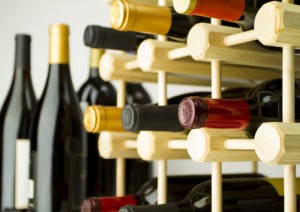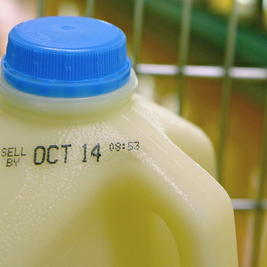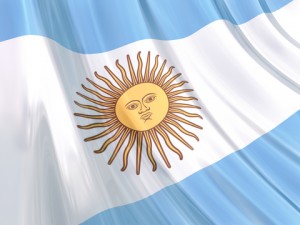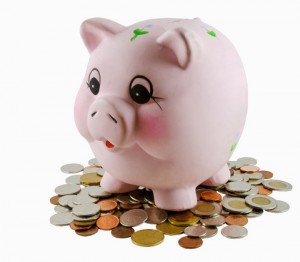by Lorri | Aug 4, 2010 | UnCorked
 Last week I found myself in a rut. It’s one many of us stray into: buying wine one bottle at a time. I have my collection of special occasion wines tucked in a dark, quiet place. It’s the other occasions — hasty weeknight dinners, spur-of-the-moment get-togethers with friends, or last-minute gifts — that lead to these single-bottle purchases.
Last week I found myself in a rut. It’s one many of us stray into: buying wine one bottle at a time. I have my collection of special occasion wines tucked in a dark, quiet place. It’s the other occasions — hasty weeknight dinners, spur-of-the-moment get-togethers with friends, or last-minute gifts — that lead to these single-bottle purchases.
In an effort to avoid the rut, I like to think of wines as a staple in my pantry. The appeal of buying wine in bulk lies not only in saving money with case discounts, but also in the pleasure and satisfaction of having an organized stash.
Everyday drinking wine is the most important staple in the wine stash. It’s where value is vital. Whether your budget is $8 or $20, look for dependable quality from reputable wineries. Buy wines you know are consistently good. If you love whites in the summer, reds in the winter, only chardonnay or despise whites altogether, your staples will be easy to buy. But if your tastes are more varied, keep a mixed case of the basics, such as chardonnay, sauvignon blanc, pinot grigio, merlot, cabernet sauvignon and shiraz.
Look for in-store specials. Many retailers offer discounts one day a week, and those days and close-out specials are a good time to replenish the stash.
Keep a few bottles of sparkling wine or champagne on hand for easy access. They also make great last-minute gifts, and you’re always ready for a celebration.
Include a few bottles of refreshing roses, Rieslings and gewurztraminers for menus involving spice and heat. To round out your wine pantry, add three to five bottles for those impromptu special occasions, like when you create a new dish or for last-minute entertaining.
What’s in my stash?
THE VALUES
- 2008 Rosemount Shiraz, Australia (about $11 retail)
- 2009 Monkey Bay Sauvignon Blanc, New Zealand (about $10 retail)
- 2008 Cellar No. 8 Cabernet Sauvignon, California (about $12 retail)
THE SPLURGES
- 2008 Pascal Jolivet Attitude Sauvignon Blanc, France (about $22 retail)
- 2008 Pierre Sparr Alsace One, France (about $20 retail)
- 2008 Banfi Rosa Regale, Italy (about $24 retail)
- 2009 Anne Amie Pinot Gris, Oregon (about $25 retail)
by Lorri | Jul 29, 2010 | UnCorked
 This time of year, my column seems to have a recurring theme — the sweltering summer heat. I get more than a few e-mails and whispered party confessions of wine drinkers forsaking cabernet sauvignon for an ice-cold beer. With a wide range of refreshing wines available, there’s no need to grab the barley brew.
This time of year, my column seems to have a recurring theme — the sweltering summer heat. I get more than a few e-mails and whispered party confessions of wine drinkers forsaking cabernet sauvignon for an ice-cold beer. With a wide range of refreshing wines available, there’s no need to grab the barley brew.
When I think refreshing and light wine, sauvignon blanc always comes to mind. The crisp acidic flavors are ideal for a summer cool-down. Each year it becomes a staple in our refrigerator to pair with our light summer meals.
THE VALUES
- 2009 Estampa Sauvignon Blanc, Chile (about $9 retail)
- 2009 Woodbridge by Robert Mondavi Sauvignon Blanc, California (about $8 retail)
THE SPLURGES
- 2009 Schug Sauvignon Blanc, California (about $20 retail)
- 2007 Halleck Vineyard Little Sister Sauvignon Blanc, California (about $36 retail)
If you keep in mind that not all rose wines are sweet, rose may be the ultimate summer refreshment. It offers the health benefits of a red wine (rose is made using the skins of the grapes) with the light, crisp qualities of white wine. Today’s rose is not the same cheap, sweet and slightly fizzy wine of the early 1970s. Quality rose wine is neither sweet nor fizzy, and many wineries are producing refreshing, bone-dry wine filled with the flavors of cherry, strawberry and raspberry.
THE VALUES
- 2009 La Vieille Ferme Rhone Rose, France (about $11 retail)
- 2009 Bodega Norton Rosado, Argentina (about $13 retail)
THE SPLURGES
- 2009 Bonny Doon Vin Gris de Cigare, California (about $18 retail)
- 2008 E. Guigal Cotes du Rhone Rose, France (about $24 retail)
by Lorri | Jul 21, 2010 | UnCorked
 A few weeks ago I ran into a store and quickly grabbed a bottle of white wine. I was hot, it was chilled and dinner was desperately simple so not much thought went into my purchase.
A few weeks ago I ran into a store and quickly grabbed a bottle of white wine. I was hot, it was chilled and dinner was desperately simple so not much thought went into my purchase.
After opening the bottle at dinner and taking a sip, I had a poignant moment. Though only 1 year old, this white wine was well past its optimal freshness. Unlike milk, wine doesn’t come with an expiration date, which can sometimes lead to randomly grabbing a disappointing bottle.
Very few white wines are made to improve with age and most deteriorate quickly. When buying white wines not intended for long-term storage, always buy the most recent vintage. I am not referring to sacred Burgundies or cult chardonnays. This tip is for wines intended for immediate consumption.
Many mid-market chardonnays are made from very ripe grapes with low acid and oak dimensions. Over time the fruit flavors diminish and you are usually left with a flabby, bitter taste and alcohol.
Light-bodied wines like sauvignon blanc and pinot grigio are appealing because of the refreshing, fruity and zippy acid. But a year or two after their release, many begin to lose these traits and become less than what they were intended to be.
The advice is the same for ordering white wine while dining out. If you ordered a 2009 from the wine list, check the bottle so you’re not served a 2008.
So, plan your aging strategy for your premium quality whites but for all the others, drink up.
THE VALUES
- 2009 Cupcake Sauvignon Blanc, New Zealand/California (about $12 retail)
- 2009 Ecco Domani Pinot Grigio, Italy (about $13 retail)
THE SPLURGES
- 2008 Spy Valley Sauvignon Blanc, New Zealand (about $19 retail)
- 2008 Brancott Reserve Sauvignon Blanc, New Zealand (about $22 retail)
by Lorri | Jul 14, 2010 | UnCorked
 If any country can satisfy the world’s thirst for value-priced red wines, it’s Argentina.
If any country can satisfy the world’s thirst for value-priced red wines, it’s Argentina.
One of the world’s top five wine producing nations, most of its wine had traditionally been consumed by Argentinians. But the consumption rate has been falling since the 1970s when the nation’s younger generations discovered soft drinks and designer beers. Subsequently, many Argentine wineries are focusing on exports.
The country’s climate and topography is considered nearly perfect for growing grapes. The wineries are in the western part of the country stretching from the northern border down to La Pampa and Rio Negro, generally following the Andes and its foothills.
In the lower elevations, conditions are hot and dry, which is ideal for making red wines. The higher elevations provide warm, sunny days and cool nights, excellent for producing white wines.
Argentina’s climate has been described as “refrigerated sunshine.” Rainfall is modest in most regions, making irrigation vital, but snowmelt from the mountains is channeled to the vineyards and provides ample water in the growing season. Argentina continues to add quality wine with exceptional value to the international market, and the land-rich nation with the perfect climate still hasn’t reached its peak.
THE VALUES
- 2007 Kaiken Malbec, Argentina (about $14 retail)
- 2007 La Linda Bonarda, Argentina (about $10 retail)
- 2008 Trapiche Malbec, Argentina (about $10 retail)
THE SPLURGES
- 2007 Luigi Bosca Reserva Malbec, Argentina (about $18 retail)
- 2008 Dona Paula Estate Malbec, Argentina (about $20 retail)
by Lorri | Jul 7, 2010 | UnCorked
 When I started writing Uncorked five years ago, the most common question was, “Can you recommend a great bottle of wine?” Today, the question is the same, with a few more words … under $20.
When I started writing Uncorked five years ago, the most common question was, “Can you recommend a great bottle of wine?” Today, the question is the same, with a few more words … under $20.
The answer is a resounding “yes.”
With the wine industry responding to consumer demand and changes in the economy, as well as shifting perceptions (great wine doesn’t have to be expensive) inexpensive, quality wines are easier to find than ever. Readily available in most retail shops, wines from California and Australia are great places to start.
It wasn’t long ago that the phrase “inexpensive Napa Valley Cabernet” was a true oxymoron. But many existing producers as well as newcomers are shifting their focus from cult winemaking to everyday winemaking.
THE VALUES
- 2009 Cline Cellars California Viognier, California (about $11 retail)
- 2008 Bogle Vineyards Merlot, California (about $10 retail)
- 2009 Renwood Lodi Viognier, California (about $12 retail)
THE SPLURGES
- 2009 Seghesio Winery Pinot Grigio, California (about $19 retail)
- 2009 Estancia Chardonnay, California (about $15 retail)
In the latter part of the 20th century, when the rest of the wine world was busy creating premium wines in the $50-$100 range, Australian producers were standing in an oversupply of grapes. This overabundance, along with consumer response, led to the Land Down Under garnering a reputation for quality, inexpensive wines. Today, Australia continues to offer great values, but with a larger than ever oversupply of grapes, consumers should remain with reputable producers who consistently offer quality wines.
THE VALUES
- 2008 Lindemans Shiraz, Australia (about $10 retail)
- 2009 Yalumba Y Series Riesling, Australia (about $13 retail)
THE SPLURGES
- 2008 Jim Barry Cover Drive Cabernet Sauvignon, Australia (about $23 retail)
- 2008 Grant Burge Miamba Shiraz, Australia (about $21 retail)
by Lorri | Jun 30, 2010 | UnCorked
 This July Fourth, I will be celebrating the United States’ independence, but I will also be reflecting on the day America gained its independence as a respected wine nation.
This July Fourth, I will be celebrating the United States’ independence, but I will also be reflecting on the day America gained its independence as a respected wine nation.
For centuries fine wine was confined inside the boundaries of prestigious European vineyards in regions such as Bordeaux and Burgundy. Mention of cabernet sauvignon or pinot noir was found only in tasting notes or journals from noble families or those who acquired prestige or wealth enough to travel across the Atlantic. These were the privileged few who savored the sacred consumption of the world’s fine wines.
But, in 1976 a Paris wine retailer, alongside Britain’s Steven Spurrier, organized a unique and original blind wine tasting of California versus France. California wines were brought not only against historic wine greats, but also against the discerning taste of the world’s most elite palates.
This blind tasting resulted in California receiving an overall rating of superior when the winners were announced: a 1973 Stag’s Leap Cabernet and a 1973 Chateau Montelena Chardonnay. You can only imagine the shock wave it sent ’round the world from the outcome of this competition.
George Taber, the only American journalist who attended and thought the event to be newsworthy, tells the story of this day of independence. His famous account of this tasting is revealed in his book, Judgment of Paris: California vs. France and the Historic 1976 Paris Tasting That Revolutionized Wine.
The 2008 docudrama Bottle Shock, available on DVD, also tells the story of the competition, but from a different perspective.
THE VALUES
- 2008 Rodney Strong Sonoma Zinfandel , California (about $20 retail)
- 2009 Bonny Doon Big House White, California (about $11 retail)
- 2008 Bouchaine Pinot Noir Carneros, California (about $20 retail)
THE SPLURGES
- 2007 Robert Mondavi Napa Valley Cabernet Sauvignon, California (about $38 retail)
- 2006 Grgich Hills Napa Chardonnay, California (about $58 retail)
- 2004 Bell Vineyards Clone 6 Cabernet Sauvignon, California (about $98 retail)
 Last week I found myself in a rut. It’s one many of us stray into: buying wine one bottle at a time. I have my collection of special occasion wines tucked in a dark, quiet place. It’s the other occasions — hasty weeknight dinners, spur-of-the-moment get-togethers with friends, or last-minute gifts — that lead to these single-bottle purchases.
Last week I found myself in a rut. It’s one many of us stray into: buying wine one bottle at a time. I have my collection of special occasion wines tucked in a dark, quiet place. It’s the other occasions — hasty weeknight dinners, spur-of-the-moment get-togethers with friends, or last-minute gifts — that lead to these single-bottle purchases. This time of year, my column seems to have a recurring theme — the sweltering summer heat. I get more than a few e-mails and whispered party confessions of wine drinkers forsaking cabernet sauvignon for an ice-cold beer. With a wide range of refreshing wines available, there’s no need to grab the barley brew.
This time of year, my column seems to have a recurring theme — the sweltering summer heat. I get more than a few e-mails and whispered party confessions of wine drinkers forsaking cabernet sauvignon for an ice-cold beer. With a wide range of refreshing wines available, there’s no need to grab the barley brew. A few weeks ago I ran into a store and quickly grabbed a bottle of white wine. I was hot, it was chilled and dinner was desperately simple so not much thought went into my purchase.
A few weeks ago I ran into a store and quickly grabbed a bottle of white wine. I was hot, it was chilled and dinner was desperately simple so not much thought went into my purchase. If any country can satisfy the world’s thirst for value-priced red wines, it’s Argentina.
If any country can satisfy the world’s thirst for value-priced red wines, it’s Argentina. When I started writing Uncorked five years ago, the most common question was, “Can you recommend a great bottle of wine?” Today, the question is the same, with a few more words … under $20.
When I started writing Uncorked five years ago, the most common question was, “Can you recommend a great bottle of wine?” Today, the question is the same, with a few more words … under $20. This July Fourth, I will be celebrating the United States’ independence, but I will also be reflecting on the day America gained its independence as a respected wine nation.
This July Fourth, I will be celebrating the United States’ independence, but I will also be reflecting on the day America gained its independence as a respected wine nation.